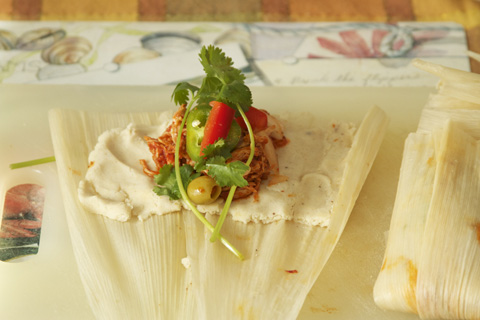
READY TO WRAP A tamale, all set to go. |
Forty-seven days before Christmas, Garnet Hill was already asking, do I want a felted Advent calendar? The deep psychological warfare of the holidays had begun. From that moment on, every piece of mail, every song, every wreath, every non-year-round light would poke and rattle me: How are you going surprise 20 people on your list with great gifts — without going into debt or driving yourself crazy?
Then my Nicaraguan cooking teacher saved me. “I’m going to make some tamales,” she said, “You wanna learn?” I’ve always wanted to learn how to make tamales. And homemade tamales would make great Christmas presents for a host of reasons: a) traditionally they’re eaten on Christmas in Mexico; b) they freeze well, and are easy for recipients to steam and serve whenever they want; c) they look like little presents, wrapped in cornhusks — even tied with a cornhusk bow, and d) friends and relatives will never guess what you’re giving them.
At her condo Jenny soaked the cornhusks and mild chili peppers separately in hot water, and cooked off a pound of smoked bacon, saving the melted fat. She boiled the chicken in water. When the chicken was cooked through, she told me to put my pen down and mix the chicken broth into the corn masa. “Don’t be scared,” she said, knowing from experience that American cooks scare easily. “This is food.” As in, not dynamite. When the flour wasn’t powdery any more, but clumpy, she poured the melted bacon fat onto the masa clumps and told me to knead it with my hands into dough. My jaw dropped at the amount of bacon fat. “This is not diet food,” she said. “This is not diet food,” I repeated, both of us laughing. You can make tamales with vegetable oil, but if you want the best flavor, bacon fat is best.
Blended in the blender, the soaked chili skins, onion, garlic, and water whirred into a tantalizing red sauce. She simmered the cooked chicken in this sauce, and then shredded the chicken by pulling at it with a fork. She opened up one of the cornhusks, and pressed the masa dough into a rectangular shape in the top half of the husk. On top of the masa, she made a small pile of shredded chicken meat topped with sliced onion, red pepper, jalapeno, fresh cilantro, and olives. Then she rolled the two husk sides together and flipped up the bottom so she had a little packet. You make a bunch of these, and steam them in a steamer basket for 20 minutes. They’re great served with beans and a salad. I asked sheepishly if I might have a second tamale. She replied, “I can eat half a dozen. Do you think it’s too much?”
This recipe is a bit different from her own tradition, but is a favorite nevertheless. “In Nicaragua we make tamales with banana leaves instead of corn husks and have different fillings,” she said. “We call them nakatameles.” She learned how to make these Mexican tamales from Mexican friends when she lived in California.
For the recipe and cooking class info visit immigrantkitchens.com.